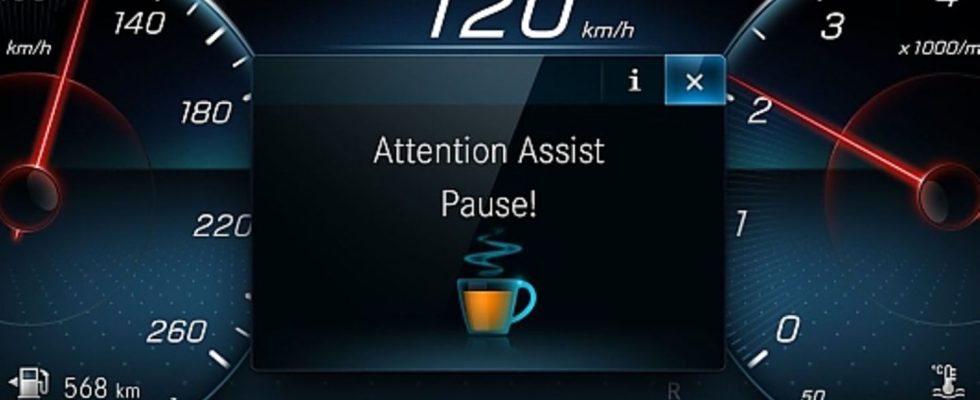Advice: These assistance systems will be mandatory from 2024
Unyielding helpers
Fatigue warning
© press-inform – the press office
From July 7, 2024, some assistance systems will be mandatory for new cars. This includes a black box that stores data in the event of an accident and an emergency lane departure warning system that actively countersteers in the event of an accident.
When it comes to road accidents, the European Union understandably doesn’t take a joke. In 2018, the EU set itself the goal of halving the number of road traffic deaths and serious injuries by 2030. The first successes on the way there are visible: the number of road deaths has been falling in Europe since the turn of the millennium. By 2050 there should be no more fatal traffic accidents. A worthwhile goal, which, however, cannot only be achieved with nice words, but requires further development of technology. To be precise, that one Assistance systems that intervene as soon as people and machines find themselves in a dangerous situation.
In order to bring the systems into cars, the EU has in “Regulation No. 2019/2144 on the type-approval of motor vehicles and motor vehicle trailers and of systems, components and separate technical units for these vehicles with a view to their general safety and the protection of the Vehicle occupants and unprotected road users” defines which assistance systems must be in every newly registered car and light commercial vehicle from July 7, 2024. In addition, you cannot achieve a top score in the prestigious NCAP test without electrical helpers. For car manufacturers, these devices are part of the path towards autonomous driving. If you look at the list, some of the assistance systems listed are already installed in most new vehicles.
Intelligent Speed Assistance (ISA) / speed warning As soon as you drive too fast, the car reports this and informs the pilot of this fact with an acoustic or visual warning (in the combination display). The car does not brake or reduce power. The driver is still responsible for how far he presses the accelerator pedal. However, for this useful facility to function smoothly, up-to-date maps and traffic sign recognition that is as error-free as possible are necessary. The latter in particular does not always work properly. Accident data storage “Well, thank you very much,” some people will now be thinking. “I don’t want to have a black box in my car that constantly saves my data.” However, with this recording device you don’t get Big Brother in your car because the data is overwritten again after a few seconds. The recordings only remain in memory in the event of an accident. That’s why this system is also called “event-related data recording (black box)”. The following data is collected, among others: position, braking, speed, inclination, recordings from the eCall system. Emergency braking assistant As the name suggests, the system brakes automatically as soon as a collision is imminent. The necessary hardware is already installed in many cars and is used in adaptive cruise control, in which the vehicle automatically brakes and accelerates depending on the traffic situation. Emergency lane keeping assistant Similar to the aforementioned emergency braking assistant, the lane keeping assistant actively intervenes with an automatic steering movement (not just warnings via a vibrating steering wheel) as soon as the vehicle is in danger of leaving the lane. This system is also already installed in many new cars, especially higher-priced ones. However, this is not a free pass, as the cameras and sensors do not always work, for example with poor road markings. The system then reports this on the display. Every time you start the car, the system is armed again. Fatigue and attention warning system Humans are not machines. This is nothing new. The longer you drive, the more likely you are to become fatigued. The system monitors steering movements, for example. If these become more jerky, the algorithm assumes that attention is decreasing. The fatigue and attention warning system then intervenes and tells the pilot to take a break. In some modern cars, a camera also monitors the driver’s face, warning him with phrases like “stay focused” if he blinks more often and his eyes remain closed for too long. Emergency brake light The same applies to the emergency brake light as for the emergency brake assistant. Some people may have noticed that the brake lights of the vehicle in front start to flicker, similar to an alarm flashing system, and thus warn the traffic behind of a significant reduction in speed. This useful device has already prevented a number of rear-end collisions. Device for installing an alcohol-sensitive immobilizer According to the wishes of the EU, all new cars must only have a standardized interface that enables the retrofitting of an alcohol-sensitive immobilizer. So such a device, which manufacturers like Volvo have been using for a long time under the name “Alcoguard”, is not mandatory. Reversing assistant As the name suggests, reversing assistant helps the driver maneuver to avoid a collision. In modern cars, this often happens in conjunction with a camera and ultrasonic sensors. Tire pressure monitoring A flat tire can have fatal consequences at high speeds. That’s why sensors continuously monitor the tire pressure of all four tires and immediately report even small deviations. This is particularly important with so-called run-flat tires, as without the technology the driver would notice the pressure drop too late or the tire would already blow up in his face. This system has also been installed in cars for some time.

